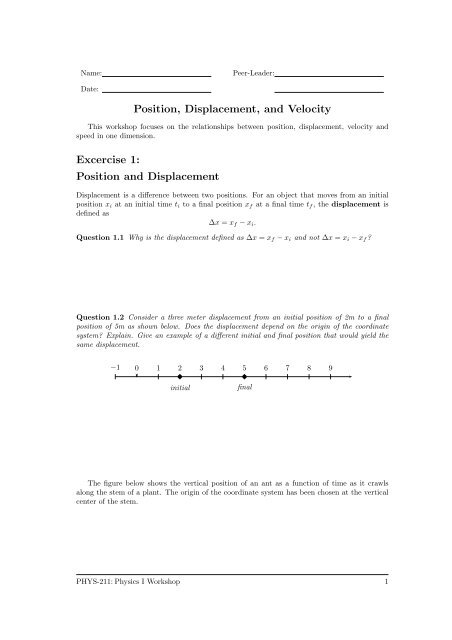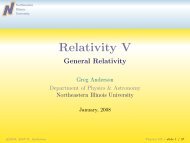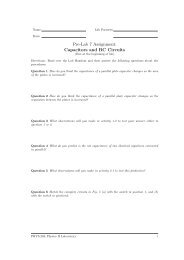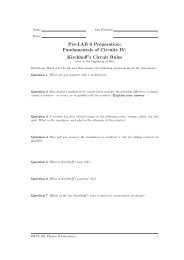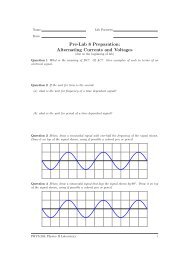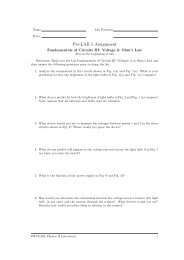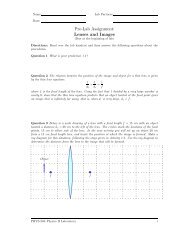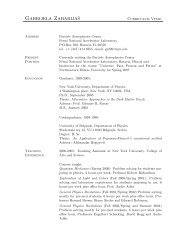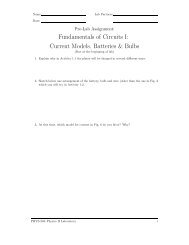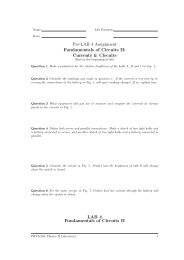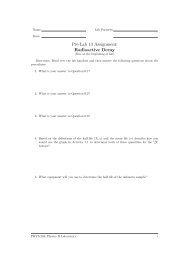Position, Displacement, and Velocity Excercise 1: Position and ...
Position, Displacement, and Velocity Excercise 1: Position and ...
Position, Displacement, and Velocity Excercise 1: Position and ...
You also want an ePaper? Increase the reach of your titles
YUMPU automatically turns print PDFs into web optimized ePapers that Google loves.
Name: Peer-Leader:<br />
Date:<br />
<strong>Position</strong>, <strong>Displacement</strong>, <strong>and</strong> <strong>Velocity</strong><br />
This workshop focuses on the relationships between position, displacement, velocity <strong>and</strong><br />
speed in one dimension.<br />
<strong>Excercise</strong> 1:<br />
<strong>Position</strong> <strong>and</strong> <strong>Displacement</strong><br />
<strong>Displacement</strong> is a difference between two positions. For an object that moves from an initial<br />
position xi at an initial time ti to a final position xf at a final time tf, the displacement is<br />
defined as<br />
∆x = xf − xi.<br />
Question 1.1 Why is the displacement defined as ∆x = xf − xi <strong>and</strong> not ∆x = xi − xf?<br />
Question 1.2 Consider a three meter displacement from an initial position of 2m to a final<br />
position of 5m as shown below. Does the displacement depend on the origin of the coordinate<br />
system? Explain. Give an example of a different initial <strong>and</strong> final position that would yield the<br />
same displacement.<br />
−1<br />
0 1 2 3 4 5 6 7 8 9<br />
initial final<br />
The figure below shows the vertical position of an ant as a function of time as it crawls<br />
along the stem of a plant. The origin of the coordinate system has been chosen at the vertical<br />
center of the stem.<br />
PHYS-211: Physics I Workshop 1
<strong>Position</strong>, <strong>Displacement</strong> <strong>and</strong> <strong>Velocity</strong> v 0.4<br />
<strong>Position</strong> (cm)<br />
3<br />
2<br />
1<br />
0<br />
-1<br />
-2<br />
-3<br />
0 1 2 3 4 5<br />
Time (s)<br />
6 7 8 9 10<br />
Question 1.3 For the graph above what is the displacement between 0 seconds <strong>and</strong> 2 seconds?<br />
What is the displacement between 2 seconds <strong>and</strong> 4 seconds? What is the net displacement from<br />
zero to ten seconds?<br />
Question 1.4 If the ant has a tiny odometer, what is the reading on the ant’s odometer after<br />
two seconds? After four seconds? After ten seconds? Is the odometer reading different than<br />
displacement? Explain.<br />
Question 1.5 Starting from the initial time t = 0, at what later time(s) is the net displacement<br />
zero? Give a time interval for which the displacement is negative.<br />
PHYS-211: Physics I Workshop 2
<strong>Position</strong>, <strong>Displacement</strong> <strong>and</strong> <strong>Velocity</strong> v 0.4<br />
Question 1.6 During the time period shown on the graph, choose an initial time <strong>and</strong> a final<br />
time that gives the greatest displacement.<br />
<strong>Excercise</strong> 2:<br />
Average <strong>Velocity</strong><br />
For an object that moves from an initial position xi at an initial time ti to a final position xf<br />
at the final time tf, the average velocity is defined as<br />
v = ∆x<br />
∆t = xf − xi<br />
tf − ti<br />
Question 2.1 In the definition of velocity, why do we use displacement in the numerator as<br />
opposed to a position?<br />
.<br />
Question 2.2 Does our formula for velocity depend on the origin of the time coordinate? That<br />
is to say if you were going to compute the average velocity of an object using the formula above<br />
would it matter what the initial time was on your stopwatch when you began? Explain.<br />
Question 2.3 Consider an object which starts from an initial location of 2 meters as shown<br />
below. If the average velocity of the object is 3m/s, where is the object located after two seconds<br />
PHYS-211: Physics I Workshop 3
<strong>Position</strong>, <strong>Displacement</strong> <strong>and</strong> <strong>Velocity</strong> v 0.4<br />
have elapsed? What would the average velocity be if instead the object was found at the position<br />
−4 m after two seconds?<br />
−5<br />
−4<br />
−3<br />
−2<br />
−1<br />
0 1 2 3 4 5 6 7 8<br />
initial<br />
Question 2.4 A kayaker paddles in a straight line at a speed of 1m/s for four seconds, <strong>and</strong><br />
then at a speed of 3m/s for one second. What is the average speed for the five second interval?<br />
Question 2.5 On the graph below, the positive direction represents north <strong>and</strong> the negative<br />
direction is south. The solid curve shows the motion of cart A. A second cart B starts from<br />
an initial position which is two meters farther to the south. The velocity of cart B is twice the<br />
velocity of cart A. Draw the position versus time for cart B on the same graph.<br />
<strong>Position</strong> (meters)<br />
3<br />
2<br />
1<br />
0<br />
-1<br />
-2<br />
-3<br />
0 1 2 3 4 5<br />
Time (s)<br />
6 7 8 9 10<br />
Question 2.6 The figure below shows a plot of position versus time. On the empty graph below<br />
make a plot the velocity as a function of time.<br />
PHYS-211: Physics I Workshop 4
<strong>Position</strong>, <strong>Displacement</strong> <strong>and</strong> <strong>Velocity</strong> v 0.4<br />
<strong>Position</strong> (meters)<br />
<strong>Velocity</strong> (m/s)<br />
3<br />
2<br />
1<br />
0<br />
-1<br />
-2<br />
-3<br />
0 1 2 3 4 5 6 7 8 9 10<br />
Time (s)<br />
3<br />
2<br />
1<br />
0<br />
-1<br />
-2<br />
-3<br />
0 1 2 3 4 5<br />
Time (s)<br />
6 7 8 9 10<br />
Question 2.7 For the graph above, what is the average velocity between two <strong>and</strong> six seconds?<br />
Question 2.8 For the graph above, compute the average velocity for the one second interval<br />
that has the largest average velocity.<br />
Question 2.9 What is the average velocity for the entire trip?<br />
PHYS-211: Physics I Workshop 5


